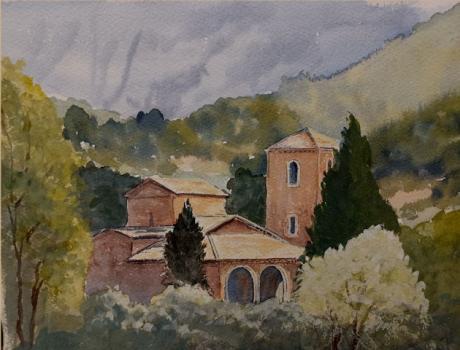" P Yates" and inscribed on the reverse
Unframed
The peace and quiet of the Picos, never more obvious than when the gentle clang of a far-off cowbell reaches your ear, it seems quite implausible to think that there was a moment in time when the first roar of the great Reconquest disturbed the tranquility in these mountains.
The seeds of a united Spain germinated from here, when the Picos de Europa were the last redoubt of Catholic Spain. The foothills were the first battlegrounds of a Holy war that would spread across the peninsula and would not finish for another 750 years.
Not a bad claim to fame for this pocket of peaks and pasture, where crumbling shepherd huts and red-roofed hamlets are often the most prevalent signs of humanity. But there are tales to be told which date back to the very dawn of Spain as we know it...
As the Christians slowly nudged the border with Moorish Spain ever southwards, the Picos de Europa mountains became a crossroad for the most important Camino pilgrim pathways to the holy city of Santiago. With Spain increasingly in thrall to North Africa, the Christians took their relics north, and a piece of the Holy Cross came to hide in the Liébana Valley in the Picos de Europa. Having rediscovered the tomb of Santiago in Galicia, pilgrims started to walk the vast distances across the peninsula, with most following the Cantabrian coast and what is today known as the Camino del Norte.
The Picos de Europa sit snugly between the north path and another established inland Francés (French) route. So many pilgrims would detour off of the coastal route to worship this most important of relics, still ‘hidden’ in the Santo Toribio monastery. Rather than turn back on themselves, they simply kept going through the mountains and emerged onto the Francès in León. If you want to follow in their footsteps and link the two Caminos, via a visit to that very same monastery, we have an exclusive itinerary that let's you do just that.
Before the Moors or Christians showed up, the Romans had long thrown down routes in the region, attracted by the mineral richness. Even with all their might, it took the presence of Holy Emperor Octavio Augusto himself to come and lead his army to victory over the local tribespeople and pacify the area. That there are still remnants of Roman pathways visible in the high mountains today is testament to the isolation and absence of large-scale human development in these hills.
The Picos de Europa ("Peaks of Europe", also the Picos) are a mountain range extending for about 20 km (12 mi), forming part of the Cantabrian Mountains in northern Spain. The range is situated in the Autonomous Communities of Asturias, Cantabria and Castile and León. The highest peak is Torre de Cerredo, at an elevation of 2650 m (8,690 ft). A widely accepted origin for the name is that they were the first sight of Europe for ships arriving from the Americas.The name can be traced to Lucio Marineo Sículo, who mentioned the Rupes Europae in 1530. Ambrosio Morales, chronist of Felipe II of Spain, mentions the Montañas de Europa in 1572.[citation needed] Prudencio de Sandoval calls them the Peñas o Sierras de Europa in 1601. The range consists of three major massifs: Central (also known as Urrieles), Eastern (Ándara) and Western (also known as the Picos de Cornión). The Central and Western massifs are separated by the 1.5 kilometres (0.93 mi) deep Cares Gorge (Garganta del Cares), with the village of Caín at its head. The waters in the Cares mostly arise from cave resurgences. Some of the water in the Cares river is diverted through a hydroelectric scheme, with a canal running in the northern wall of the gorge to Camarmeña.
Almost all of the rock in the Picos is limestone, and glacial action has contributed to create an impressive area of alpine karst. The highest peak is Torre de Cerredo, with an altitude of 2,650 metres at 43°11′51″N 4°51′06″W. Many other peaks reach altitudes of over 2,600 m. The area is popular with mountaineers, climbers and mountain walkers. There is a good network of well-established mountain refuges. The best-known climbing site is the Naranjo de Bulnes or Picu Urriellu, in the Urrieles massif which can be considered the most famous climb in Spain.[citation needed]
Vega de Liordes, an enclave in the León sector of Picos de Europa belonging to the municipality of Posada de Valdeón registered −35.8 °C (−32.4 °F) on January 7, 2021

